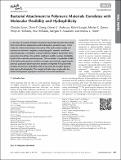| dc.contributor.author | Sanni, Olutoba | |
| dc.contributor.author | Chang, Chien-Yi | |
| dc.contributor.author | Davies, Martyn C. | |
| dc.contributor.author | Williams, Philip M. | |
| dc.contributor.author | Williams, Paul | |
| dc.contributor.author | Alexander, Morgan R. | |
| dc.contributor.author | Hook, Andrew L. | |
| dc.contributor.author | Anderson, Daniel Griffith | |
| dc.contributor.author | Langer, Robert S | |
| dc.date.accessioned | 2015-06-30T18:54:56Z | |
| dc.date.available | 2015-06-30T18:54:56Z | |
| dc.date.issued | 2014-12 | |
| dc.date.submitted | 2014-11 | |
| dc.identifier.issn | 21922640 | |
| dc.identifier.uri | http://hdl.handle.net/1721.1/97595 | |
| dc.description.abstract | A new class of material resistant to bacterial attachment has been discovered that is formed from polyacrylates with hydrocarbon pendant groups. In this study, the relationship between the nature of the hydrocarbon moiety and resistance to bacteria is explored, comparing cyclic, aromatic, and linear chemical groups. A correlation is shown between bacterial attachment and a parameter derived from the partition coefficient and the number of rotatable bonds of the materials' pendant groups. This correlation is applicable to 86% of the hydrocarbon pendant moieties surveyed, quantitatively supporting the previous qualitative observation that bacteria are repelled from poly(meth)acrylates containing a hydrophilic ester group when the pendant group is both rigid and hydrophobic. This insight will help inform and predict the further development of polymers resistant to bacterial attachment. | en_US |
| dc.description.sponsorship | Wellcome Trust (London, England) (Grant 085245) | en_US |
| dc.description.sponsorship | European Metrology Research Programme (IND56) | en_US |
| dc.language.iso | en_US | |
| dc.publisher | Wiley Blackwell | en_US |
| dc.relation.isversionof | http://dx.doi.org/10.1002/adhm.201400648 | en_US |
| dc.rights | Creative Commons Attribution | en_US |
| dc.rights.uri | http://creativecommons.org/licenses/by/4.0/ | en_US |
| dc.source | Wiley Blackwell | en_US |
| dc.title | Bacterial Attachment to Polymeric Materials Correlates with Molecular Flexibility and Hydrophilicity | en_US |
| dc.type | Article | en_US |
| dc.identifier.citation | Sanni, Olutoba, Chien-Yi Chang, Daniel G. Anderson, Robert Langer, Martyn C. Davies, Philip M. Williams, Paul Williams, Morgan R. Alexander, and Andrew L. Hook. “Bacterial Attachment to Polymeric Materials Correlates with Molecular Flexibility and Hydrophilicity.” Advanced Healthcare Materials 4, no. 5 (December 9, 2014): 695–701. | en_US |
| dc.contributor.department | Massachusetts Institute of Technology. Institute for Medical Engineering & Science | en_US |
| dc.contributor.department | Harvard University--MIT Division of Health Sciences and Technology | en_US |
| dc.contributor.department | Massachusetts Institute of Technology. Department of Chemical Engineering | en_US |
| dc.contributor.department | Koch Institute for Integrative Cancer Research at MIT | en_US |
| dc.contributor.mitauthor | Anderson, Daniel Griffith | en_US |
| dc.contributor.mitauthor | Langer, Robert | en_US |
| dc.relation.journal | Advanced Healthcare Materials | en_US |
| dc.eprint.version | Final published version | en_US |
| dc.type.uri | http://purl.org/eprint/type/JournalArticle | en_US |
| eprint.status | http://purl.org/eprint/status/PeerReviewed | en_US |
| dspace.orderedauthors | Sanni, Olutoba; Chang, Chien-Yi; Anderson, Daniel G.; Langer, Robert; Davies, Martyn C.; Williams, Philip M.; Williams, Paul; Alexander, Morgan R.; Hook, Andrew L. | en_US |
| dc.identifier.orcid | https://orcid.org/0000-0001-5629-4798 | |
| dc.identifier.orcid | https://orcid.org/0000-0003-4255-0492 | |
| mit.license | PUBLISHER_CC | en_US |
| mit.metadata.status | Complete | |
